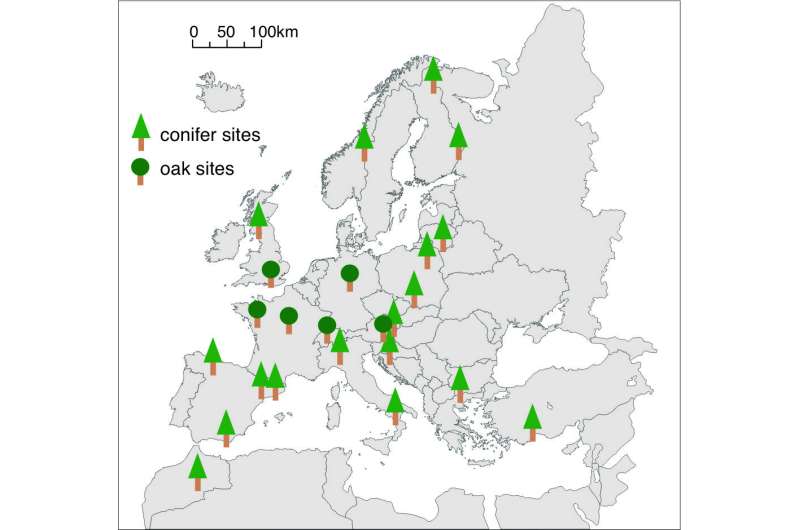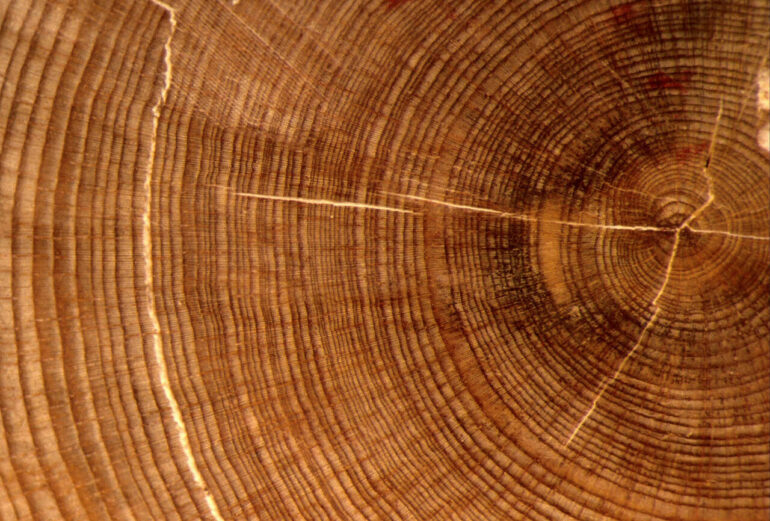The 2015–2018 summer droughts have been exceptional in large parts of Western and Central Europe over the last 400 years, in terms of the magnitude of drought conditions. This indicates an influence of man-made global warming. However, multi-year droughts have occurred frequently in the 17th and 18th century, although not as severe.
This is the result of a new study in the journal Communications Earth & Environment. It was conducted by a research team led by Mandy Freund from the University of Melbourne and Gerhard Helle from the GFZ German Research Centre for Geosciences. They reconstructed European summer hydroclimate by analyzing the isotopic ratios of carbon (13C/12C) and oxygen (18O/16O) in tree-rings from a European network of forest sites.
It is the first spatial field reconstruction based on highly climate-sensitive tree-ring isotopes. This provides researchers with a unique tool for investigating climatic developments over the past centuries, both in a global overview and in a regionally differentiated manner.
European hydroclimate development
Recently, Europe has seen an increase in floods and droughts. These extreme events are part of the complex dynamics of European hydroclimate. Obtaining a precise spatially-resolved picture of the dynamics in frequency and intensity of extremes at regional to local scale is a challenge, especially in the context of longer-term climatic variability. Little is known about the long-term, spatiotemporal hydroclimatic variability across Europe due to the rather sparse availability of spatially explicit data series that properly reflect regional differences.
The European summer drought from 2015 to 2018 has particularly caused discussions about whether it falls within the normal range of climate fluctuations or is a result of anthropogenic warming.
New approach to reconstructing the hydro-climate of the last 400 years
To resolve this issue a spatially resolved reconstruction of European hydroclimate over the last 400 years was developed and published in the journal Communications Earth & Environment. It is based on the analysis of stable carbon and oxygen isotopes, i.e. variants of these elements with different masses, in old tree stands from 26 forest sites across Europe. The isotope ratios of carbon 13C to 12C and oxygen 18O to 16O are indicators of drought and moisture, respectively, at the time of tree growth.
In comparison to other natural environmental or climate archives like sediments in lakes or glacial ice, trees are widely distributed and their tree rings provide annually-resolved and absolutely-dated information about hydroclimatic changes over long periods of time and at relevant temporal frequencies from annual to multi-centennial.
The study was largely designed and led by Mandy Freund, former climate scientist at GFZ German Research Centre for Geosciences and now at CSIRO in Melbourne, Australia. It originates from an initiative of GFZ section 3.4 Climate Dynamics and Landscape Evolution, especially by Gerhard Helle, head of the Tree Ring Laboratory, and of Ulrich Cubasch, professor at the Institute for Meteorology, Freie Universität Berlin, as part of the GEO.X Research Network for Geosciences in Berlin and Potsdam. Further contributions come from colleagues of other Helmholtz-Centers (AWI, FZJ) and the University of Melbourne.

Locations of the trees for isotope analysis, distributed throughout Europe. © G. Helle / GFZ
Unusually severe drought 2015-2018 and past climate phases
“Our study indicates that the multi-year 2015-2018 summer drought event was—in its intensity—highly unusual in the multi-century context and unprecedented for large parts of central and western Europe. This suggests that the European summer droughts during the last years are potentially being influenced by anthropogenic warming,” says Freund.
However, the reconstruction provides evidence that multi-year droughts have also occurred in the past, particularly during the so-called Maunder Minimum between 1645 and 1715, a period during the so-called Little Ice Age, when solar irradiance was lower than today and sunspots were rare. This surprising observation of multi-year droughts during low solar irradiance remains subject of future research.
“All in all, we found three distinct phases of European hydroclimate variability coinciding with the Maunder Minimum and the end of the Little Ice Age around 1860,” said Daniel Balting from AWI, Bremerhaven.
From 1600 to about 1650, a phase of rather humid climate, mainly in central-western and north-western Europe, then for about two hundred years a rather dry period with the described prolonged droughts mainly in the Mediterranean, eastern and northern Europe, and from about 1875 a phase with milder summer climate that lasted until the middle of the 20th century. From then on, researchers observe a trend towards drier conditions, possibly related to the anthropogenic warming.
Key method: Investigation of isotope ratios in tree rings
“Tree-ring stable isotope records are very climate-sensitive fingerprints of summer moisture conditions. They are largely independent of tree species, tree age and site location. As such tree-ring stable isotopes differ from the more classical dendrochronological parameters of tree ring width and wood density,” explains Freund, principal investigator of the study.
At each of the 26 sites, cellulose was obtained from annual rings of old, living trees and examined using standard isotope analysis methods. At the same time, the samples could be precisely dated using dendrochronological methods.
The climate signals contained within carbon and oxygen isotope ratios tree rings, originate from slightly different processes.

Principle of minimally invasive removal of a wood sample from a living tree trunk using an increment borer. © G. Helle / GFZ
The carbon isotope ratios 13C to 12C in tree rings come from the way plants function during photosynthesis. This process is controlled by tiny openings in the leaves called stomata. The plants use the stomata to regulate the amount of CO2 they take in and the amount of water vapor they transpire into the atmosphere.
During photosynthesis in leaves and needles the CO2-fixing enzyme preferentially takes up CO2 with the lighter 12C. When it is dry, trees close their stomata to conserve water, which also limits the amount of CO2 they take in and causes them to take up CO2 with the heavier 13C for conversion into sugar and finally tree-ring cellulose.
The oxygen isotope ratios 18O to 16O in tree rings are affected by physical processes that involve the atmosphere’s need for moisture, based on factors such as air temperature and humidity, as well as the amount, source, and history of rainfall.
In addition, during plant transpiration isotopically lighter (less 18O) water vapor transferred to the atmosphere while isotopically heavier water (more 18O) remains in the leaves and needles imprinting the oxygen isotope signature of tree-ring cellulose. Drought usually increases plant transpiration leading to more 18O in the tree rings.
Advantages of trees as climate archives
“High quality reconstructions of hydroclimate variability based on tree-ring stable isotopes are not new, however, this is the first network approach to establish a climate field reconstruction spanning the entire European continent,” says co-author Gerhard Schleser from the Forschungszentrum Jülich (FZJ).
To understand the spatial complexity of the large-scale European hydroclimate, more spatially explicit, long-term data sets are needed from all kinds of climate archives. Multi-century climate data are essential for the validation of climate models including comparisons to other paleoclimate, historical, and archaeological data sets.
Gerhard Helle, head of the Tree Ring Laboratory at GFZ section 4.3 and specialist in tree-ring stable isotope analysis says, “Ongoing efforts to consolidate the network of tree-ring isotopic data will provide historical dimensions to other observations, e.g. from climate stations or satellites. Those methods are unique in terms of spatial coverage, but lack, what tree-ring analysis can provide: long-term information that is crucial to improve our understanding on climate change and the corresponding local to regional impacts on the human habitat.”
More information:
Mandy B. Freund et al, European tree-ring isotopes indicate unusual recent hydroclimate, Communications Earth & Environment (2023). DOI: 10.1038/s43247-022-00648-7
Provided by
Helmholtz Association of German Research Centres
Citation:
European summer droughts since 2015 most severe in centuries, but multi-year droughts also happened in the past (2023, February 16)
